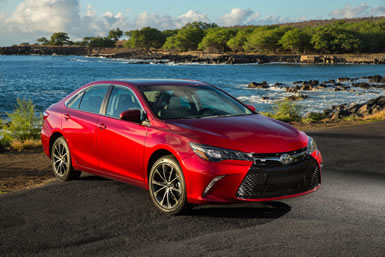|
|

The 2017 Toyota Camry Hybrid Review: The midsize Toyota Camry sedan has enjoyed the top spot in car sales in the U.S. for the last 14 years. Now in its 35th year and seventh generation, it remains a hit. What folks may not know is that Toyota sells lots of other hybrids besides the Prius. There’s an Avalon, Highlander and RAV4 Hybrid offered, and even a Camry model. While it’s not as fuel efficient as the Prius, the Camry Hybrid still is significantly more green than the gasoline-only models.
Inside, every Camry features a swirling flow of curves and overlapping panels that’s stimulating to the eye. The dash and door wear the requisite stitching that reads “upscale” today. Materials are good but are below, say, an Audi for fineness.
Regular Camrys come with either a 178-horsepower, 2.5-liter four-cylinder engine (with 170 lb.-ft. of torque) or a 268-horsepower, 3.5-liter V6 (with 248 lb.-ft. of torque). The third option is the hybrid Synergy Drive System, which combines a 2.5-liter four with a 105-kW electric motor to net 200 horsepower.
Like a good hybrid, it’s programmed to use electricity or gasoline depending on the driving situation. It can use only battery power when, say, cruising down a 25-mph suburban street. In fact, you can select the EV Mode button and, for up to 1.6 miles at speeds below 25 mph, tell the gas engine to take a break.
I drove my Ruby Flare Pearl test car just as I would any other vehicle. I could hear the gas engine start up when I got on the freeway, but I also noticed that if was in slow commute traffic or on streets in town, the battery would often be turning the wheels. The car’s computer makes the decision, but you can guide it by applying the accelerator gently and braking considerately.
The car shoots from 0-60 mph in just 7.6 seconds, which is relatively speedy. You do lose some trunk space for the battery, but otherwise, you really don’t see the difference. I was still able to stash a bass guitar and small amplifier in there.
Like other Camrys, the Hybrid comes in multiple levels. The base car is the LE, but there’s a sporty SE or the top-level XLE, like my test car. The LE includes such things as dual climate control, a backup camera, cruise control, power windows and locks, and a modern Optitron instrumentation display.
Step up to the SE for 17-inch alloys instead of 16-inch steel wheels. And, you get a sport tuned suspension, leather-wrapped steering wheel, power seats and other style enhancements.
The XLE gives you leather chairs, the Entune 10-speaker Audio Plus system with navigation, and much more. You decide.
The EPA’s ratings are a major part of driving a hybrid. The agency claims that the Camry Hybrid gets 38 miles per gallon Combined, with 40 City and 37 Highway. Compare that to the 4-cylinder Camry, which earns 27 Combined, with 24 City and 33 Highway respectively. I averaged a disappointing 28.9 mpg.
The Camry Hybrid, unlike other Camrys, uses a continuously-variable automatic transmission (CVT). The CVTs use belts instead of gears to come up with the ideal ratio anytime depending on driving conditions, including accelerating on to the freeway or starting up a hill. You can set the transmission in “B” for more regenerative braking, and the car will slow down a little when you lift off the accelerator, generating some power to recharge the battery.
You can select a driving mode, ECO, Normal, or Sport. I used ECO mostly. It mutes accelerator response and lowers the climate control to improve fuel efficiency.
Pricing for the LE with nothing extra begins at $27,655. The XLE starts at $31,005. But wait! You can add in a lot of extras to a Camry Hybrid. How about Safety Connect, with stolen vehicle locator and emergency assistance? A blind spot monitor system? The Homelink transceiver and a theft alarm?
The Entune Premium JBL system adds tons of features and apps. The Advanced Technology Package brings with it a pre-collision system, dynamic radar cruise control, and automatic high beams. When you start piling on the goodies, you get a test car like mine, with a MSRP $36,351 price tag. By Steve Schaefer © AutoWire.Net - San Francisco
The 2017 Toyota Camry Bottom Line Review provided by: Tony Leopardo © AutoWire.Net
The Bottom Line: The 2017 Toyota Camry. What’s not to like about a midsize sedan? There’s plenty of room for you and three or four other folks. You will not stand out in any way from the mass of travelers, of course, but that’s not what Camrys do. They are very efficient, and for their size, provide reliable transportation with a minimum of fuss.
This latest Camry was significantly restyled a couple of years ago, and flaunts the ferocious mouth that all Toyotas bare now. There’s more texture to the side panels, and the overall look carries a little more flair than before And maybe, just for those reasons alone, you should “Drive one, Buy one, Today ©”. This Bottom Line Review is provided by: Tony Leopardo © AutoWire.Net
“Tony the Car Guy” is an automotive writer, editor and publisher in the San Francisco Bay Area. If you have a question or comment for Tony send it to TonyLeo@pacbell.net or visit AutoWire.Net at www.autowire.net - And remember: “You Are What You Drive ©”

Column Name: Camry Hybrid is greener than the gas only models
Topic: The 2017 Toyota Camry Hybrid
Word Count: 957
Photo Caption: The 2017 Toyota Camry Hybrid
Photo Credits: Toyota Internet Media
Series #: 2017 - 14
Download
the Microsoft Word version here:
2017 Toyota Camry
Download the Original Image File here:
2017 Toyota Camry


|
